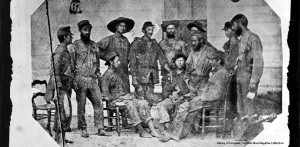In the village of Appomattox Courthouse, Virginia, a small bell rang four times during the afternoon of April 9, 2015. It marked General Robert E. Lee’s surrender of the Army of Virginia to Union General U. S. Grant. The bell was a treasured possession of a former slave in the village. Each time the bell rang; it reminded bystanders the event marked the end of the American Civil War, one of the most tragic events in our national history. By 3:15 that afternoon, bells were ringing throughout the country.
It would take until late May 1865 for all Confederate units to surrender and wend their way home. Union soldiers marched or rode trains to Washington, D. C., for a two-day long parade celebrating victory and the freedom of former slaves. But Confederates trudged homeward, in groups of three to five men. They had no food, any clothing or sturdy boots, and the path was generally unknown to them.
As the Confederate men walked, they had time to think about the loss of the war. The vast majority was desolated. Four years of war, hunger, and loneliness only to return to homes and fields destroyed by the enemy. Texas Confederates had the longest trek and must have really worked themselves up by they time they left Louisiana. As they crossed into Texas, they had no intention of acknowledging defeat or becoming reconstructed. As a result they created an environment of hate, destruction, and terror for all former slaves, Union supporters, Freedmen’s Bureau agents, and Union soldiers, especially throughout North Texas.
Even as early as March 1865 roving bands of guerillas infested Red River County and plundered Clarksville. As summer approached, newspapers commented on the rapid increase of crime, with accounts of robberies, murders, and wholesale arson. The Galveston Daily News reported that men of “all grades seem to have entered on a career of crime and doubtless found it profitable since they committed their deeds without impunity.” There was no civil law. Sheriffs and judges were helpless while murderers came and went at will.
Conditions remained the same or worsened over the next four years. The 6th U. S. Cavalry originally sent to Texas to protect settlers on the frontier, was ordered to Northeast Texas to serve in the occupation of the region and to defuse the violence. Finally General J. J. Reynolds of the U. S. Army placed a $1,000 reward on the heads of Ben Bickerstaff, Bob Lee, and Cullen Montgomery Baker, the three leaders of what became known as the War of Reconstruction. As the November elections neared in 1868, Bickerstaff and Lee led a group estimated to number between 200 and 500 men to surround Sulphur Springs. Two more companies of Union soldiers saved the town at the last minute.
Suddenly in early 1869 Baker was killed by his brother-in-law, Lee was killed by supporters of his arch-enemy Louis Peacock, and Bickerstaff was eliminated by irate storekeepers in Alvarado. The violence receded. Those unreconstructed Confederates moved farther west. Miraculously, women and children who had been confined to their homes after dark by fear found they were now free. Life was good!

